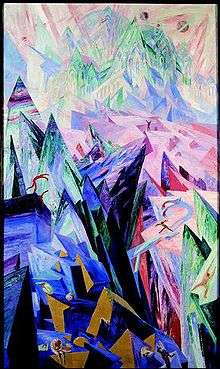Wenzel Hablik

Wenzel August Hablik (4 August 1881 – 23 March 1934), also known as Wenceslav Hablik and Wilhelm August Hablik, was a painter and graphic artist, architect, designer, and craftsman of the early twentieth century, associated with German Expressionism.[1][2]
Biography

Hablik was born in Brüx, Bohemia (now the city of Most in the Czech Republic). In later life he recalled that at the age of six, he found a specimen of crystal, and saw in it "magical castles and mountains" that would later appear in his art.[3]
More pragmatically, he trained as a master cabinetmaker, in Teplitz, Vienna, and Prague. He settled in Itzehoe in 1907, where he pursued architectural and interior design projects. Hablik produced designs for furniture, textiles, tapestries, jewelry, cutlery, and wallpapers. He married the weaver and fabric designer Lisbeth Lindemann (1879–1960) in 1917; they shared a workshop and studio in Itzehoe.
Hablik became best known, however, for his etchings and paintings and his links with major German Expressionist figures and movements, including the Arbeitsrat für Kunst and the Glass Chain. In 1909 Hablik published his Creative Forces ("Schaffende Kräfte"), "a portfolio of twenty etchings portraying a voyage through an imaginary universe of crystalline structures" that "represents the most significant accomplishment of his career."[4] Hablik also published other portfolios of his etchings, The Sea ("Das Meer", 1918) and Architectural Cycle — Utopia ("Cyklus Architektur — Utopie," 1925). Some of Hablik's designs, particularly of lamps and small sculptures, relate to and express the "utopian crystalline" forms of his etchings.

Hablik maintained a strong lifelong interest in crystals and geological forms generally. His visual art is notable for its highly imaginative and fanciful aspects; he created depictions of temples, flying cities, and crystal chasms.[5]
A catalogue in the artist's autograph lists some 600 artworks; about 250 oil paintings by Hablik are known at present. He produced portraits, landscapes, nude figures, and pictures showing Symbolist influences. A tour of South America in 1925–26 inspired him to create paintings of cactuses and flowers.
Hablik died at Itzehoe in 1934. A Wenzel Hablik Museum was established in the city in 1995. The museum contains much of his art, as well as his collections of crystals and minerals, seashells and snails.
Selected quotes
Selected quotes from Hablik's Glass Chain letters:[6]
- "Come and join the struggle against all things negative and corrupting."
- "Your ideas should be as irresponsibly free as a bird....Let us create a fresh atmosphere, a pure aura of spirit, wit, and joy. "
- "Where are you, prophets? — the heralds of the new life, telling of the new suns — moons — and stars!"
References
- ↑ Anthony Tischhauser and Eugene Santomasso, W. Hablik, Designer, Utopian, Architect, Expressionist, Artist, 1881–1934, London, Architectural Association Publications, 1980.
- ↑ Anthony Tischhauser, "Wenzel Hablik: Crystal Utopias," Architectural Association Quarterly, Vol. 12 No. 3 (1980).
- ↑ Dario Gamboni, Potential Images: Ambiguity and Indeterminacy in Modern Art, London, Reaktion Books, 2002; p. 151.
- ↑ Timothy O. Benson et al., Expressionist Utopias, Berkeley, University of California Press, 2001; p. 210.
- ↑ Benson et al., pp. 9, 36, 38, 40, 42, and ff.; 209–12.
- ↑ Eric D. Weitz, Weimar Germany: Promise and Tragedy, Princeton, NJ, Princeton University Press, 2007; p. 174.
External links
![]() Media related to Wenzel Hablik at Wikimedia Commons
Media related to Wenzel Hablik at Wikimedia Commons